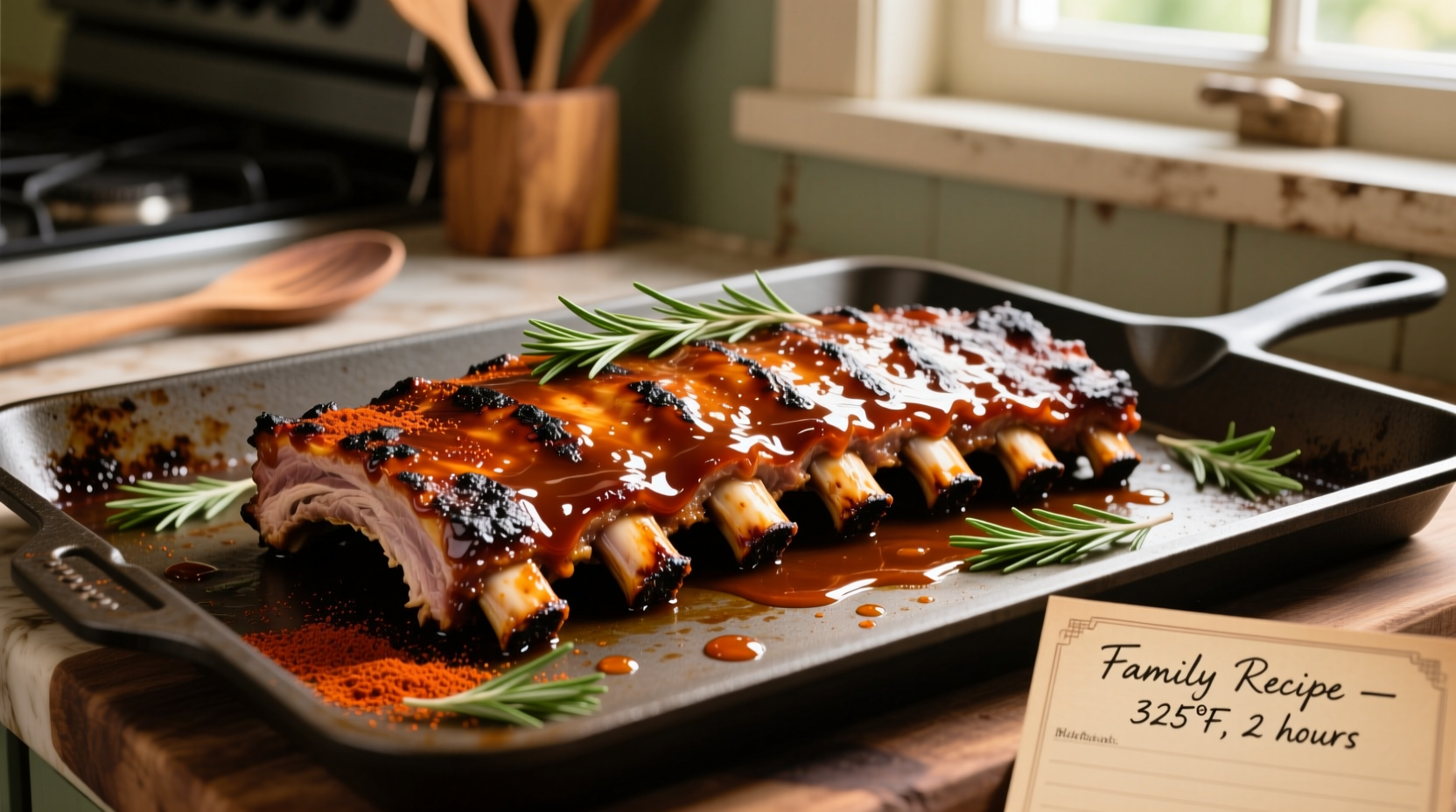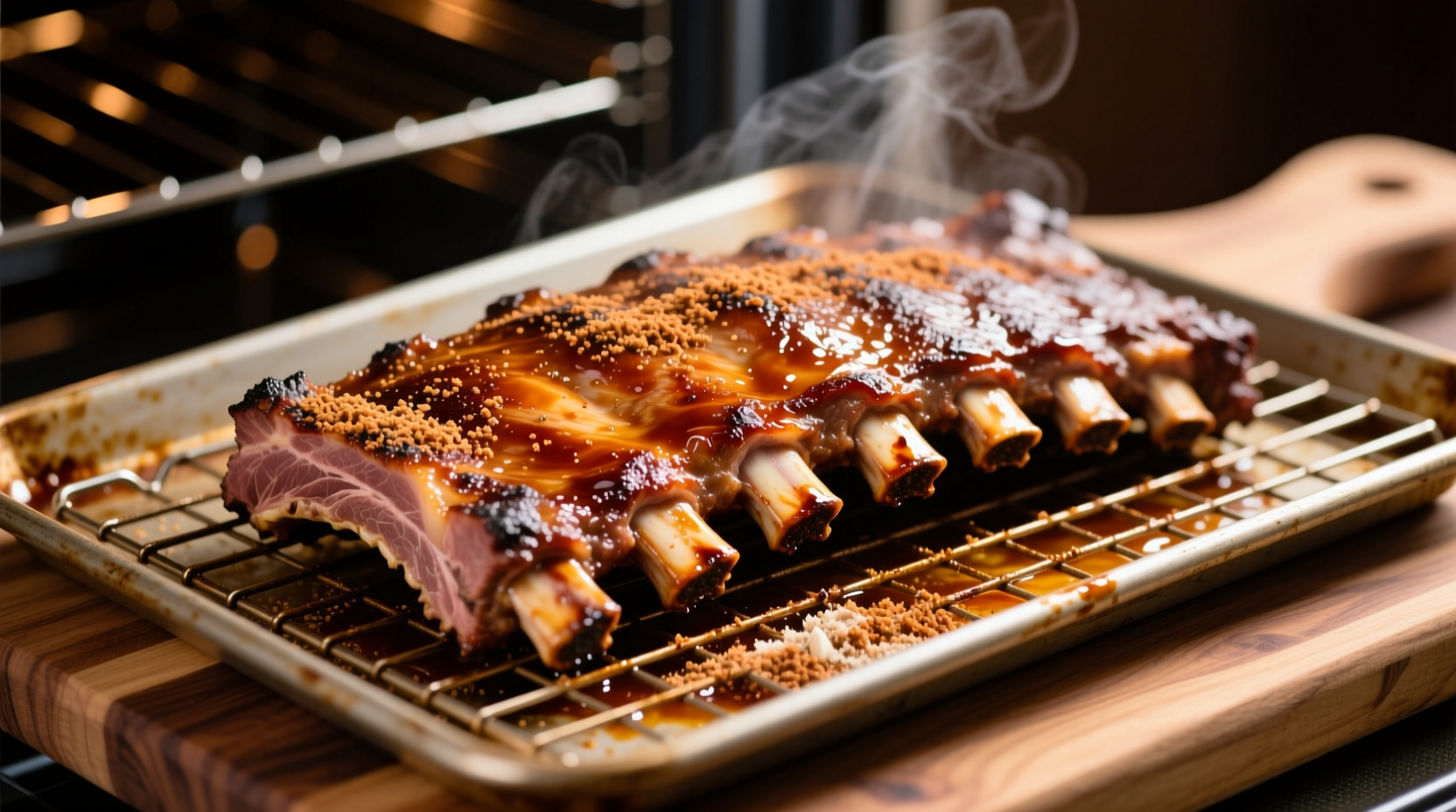Nothing beats the aroma of perfectly cooked ribs filling your kitchen. If you've ever wondered how long to cook ribs in the oven at 350, you're not alone. Thousands of home cooks search for this precise information weekly, seeking that perfect balance between tender meat and structural integrity. This comprehensive guide delivers exactly what you need: scientifically-backed timing, practical preparation steps, and professional chef techniques you can implement immediately.
The Science Behind Perfect Oven-Cooked Ribs
Cooking ribs at 350°F creates the ideal environment for collagen breakdown without drying out the meat. At this temperature, the connective tissues transform into gelatin while the fat renders slowly, resulting in that signature fall-off-the-bone texture home cooks crave. According to USDA Food Safety and Inspection Service guidelines, pork should reach a minimum internal temperature of 145°F with a 3-minute rest period for safety, though ribs benefit from slightly higher temperatures (195-205°F) for optimal tenderness.
| Rib Type | Approximate Weight | Cooking Time at 350°F | Internal Temp for Doneness |
|---|---|---|---|
| Baby Back Ribs | 1.5-2.5 lbs | 2-2.25 hours | 195-203°F |
| Spare Ribs | 2.5-3.5 lbs | 2.25-2.5 hours | 195-205°F |
| St. Louis Cut | 2-3 lbs | 2.25-2.5 hours | 195-205°F |
| Beef Back Ribs | 2-3.5 lbs | 2.5-3 hours | 200-205°F |
Preparation Essentials for Oven-Perfect Ribs
Proper preparation makes the difference between good ribs and exceptional ribs. Before you even preheat your oven, follow these critical steps:
Membrane Removal Technique
The silverskin membrane on the bone side prevents seasoning penetration and causes uneven cooking. To remove it:
- Slide a butter knife under the membrane at one end
- Lift gently until you can grab it with a paper towel
- Pull steadily at a 45-degree angle
- Repeat if necessary for complete removal
Seasoning Application
Apply a light coat of yellow mustard (acts as binder), then generously season with your dry rub. Let sit for at least 30 minutes at room temperature before cooking. This allows flavors to penetrate while bringing the meat to optimal starting temperature.

Step-by-Step Cooking Process at 350°F
Follow this precise method for consistently perfect ribs every time you cook ribs in oven at 350:
Phase 1: Initial Cooking (First 90 Minutes)
Place ribs bone-side down on a foil-lined baking sheet with a wire rack. Cook uncovered for 90 minutes. This dry-heat phase renders fat and begins the tenderizing process. Rotate the pan halfway through for even cooking.
Phase 2: Foil Wrap and Finishing (Next 30-60 Minutes)
After 90 minutes, check internal temperature. If below 165°F, wrap ribs tightly in foil with 2 tablespoons of liquid (apple juice, broth, or water). Return to oven for 30-60 minutes until reaching 195-205°F internally. This steam environment accelerates collagen breakdown.
Phase 3: Glazing and Resting
Remove foil, apply sauce if desired, and return to oven for 10-15 minutes to set the glaze. Then, let ribs rest for 10-15 minutes before slicing. This resting period allows juices to redistribute throughout the meat.
Contextual Factors That Affect Cooking Time
While 2-2.5 hours serves as a reliable baseline for how long to cook ribs in oven at 350, several contextual factors influence the exact timing:
- Oven accuracy: Most home ovens fluctuate 15-25°F. Use an independent oven thermometer for precision.
- Rack position: Middle rack provides most even heat distribution.
- Pan material: Dark metal pans cook faster than glass or ceramic.
- Starting temperature: Cold ribs from the refrigerator add 15-20 minutes to cooking time.
- Altitude: Above 3,000 feet, increase cooking time by 5-10% due to lower boiling points.
Troubleshooting Common Rib Cooking Issues
Even with precise timing, challenges can arise. Here's how to address them:
Ribs Cooking Too Fast
If your ribs are browning too quickly but not yet tender:
- Reduce oven temperature to 325°F
- Wrap immediately in foil
- Move to a lower oven rack position
Ribs Not Tender After Recommended Time
If ribs haven't reached 195°F after 2.5 hours:
- Re-wrap tightly in foil with additional liquid
- Continue cooking in 15-minute increments
- Check temperature in multiple spots (thicker areas cook slower)
Proven Temperature Verification Methods
Don't rely solely on timing when cooking ribs at 350 degrees in oven. Use these verification techniques:
- Thermometer test: Insert probe thermometer into thickest part (avoiding bone). Target 195-205°F.
- Bend test: Using tongs, lift ribs from one end. They should bend easily and cracks may appear in the surface.
- Meat separation: Meat should pull back slightly from the bones (about 1/4 inch).
- Fork test: A fork should slide between bones with slight resistance.
Historical Evolution of Oven Rib Cooking Techniques
Rib cooking methods have evolved significantly over the decades. In the 1950s, ribs were typically boiled first to tenderize, resulting in flavorless meat. The 1970s brought the "3-2-1" method (3 hours smoke, 2 hours wrapped, 1 hour glaze) from competitive barbecue. Modern oven techniques have adapted these principles for home cooking, with precise temperature control replacing guesswork. According to the American Culinary Federation's historical records, the shift to oven cooking at consistent temperatures like 350°F began gaining popularity in the early 2000s as home ovens became more accurate and reliable.
Serving and Storage Recommendations
For the best experience when cooking ribs in oven at 350:
- Cutting technique: Slice between bones with a sharp knife using a gentle sawing motion
- Serving temperature: Serve between 140-160°F for optimal texture and safety
- Refrigeration: Store leftovers in airtight container for up to 4 days
- Reheating: Warm in 300°F oven with damp paper towel for 15-20 minutes
Why This Method Works Better Than Alternatives
Compared to lower temperature methods (225-275°F), cooking ribs at 350°F offers several advantages for home cooks:
- Reduced cooking time fits better with busy schedules
- Less chance of drying out due to shorter exposure to heat
- Better caramelization of seasonings and sauces
- More consistent results in standard home ovens
However, this method works best for smaller rib portions (under 3 pounds). Larger racks benefit from lower temperatures to ensure even cooking throughout.











 浙公网安备
33010002000092号
浙公网安备
33010002000092号 浙B2-20120091-4
浙B2-20120091-4